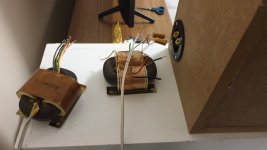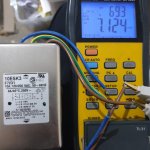Newvirus is wrong!!!! Powdered iron core permeability varies substantially with both AC and DC excitation - just read the data sheet.of the powdered iron mix in question, available at micrometals.com. The higher the permeability of the powdered iron mix, the larger the permeability variation with DC and AC flux.
Toroidal inductors wound on a non-magnetic substrate (like Micrometals mix 0, phenolic plastic) make good crossover indiuctors as the toroidal geometry makes them less susceptible to magnetic cross-coupling, unlike rod inductors. The mu=1 core permeability means you need to use more turns for a given inductance. The inductance for a plastic core will also not change with excitation level, nor will the inductor saturate - it will merely burn up if you put too much current through it.
Toroidal inductors wound on a non-magnetic substrate (like Micrometals mix 0, phenolic plastic) make good crossover indiuctors as the toroidal geometry makes them less susceptible to magnetic cross-coupling, unlike rod inductors. The mu=1 core permeability means you need to use more turns for a given inductance. The inductance for a plastic core will also not change with excitation level, nor will the inductor saturate - it will merely burn up if you put too much current through it.
Vickey2k8 -
The performance of your toroidal inductor would depend on what material you used for the core. If you use an ungapped ferrite, it will saturate at moderate signal levels and cause the filter frequency to vary all over the place. Powdered iron will shift in permeability at high signal levels, though less than an ungapped ferrite core. . When using powdered metal cores, generally the lower the permeability, the lower the permeability shift with signal level. A gapped ferrite E core would be a good choice, as the inductance will be relatively stable at signal levels short of saturation.
The performance of your toroidal inductor would depend on what material you used for the core. If you use an ungapped ferrite, it will saturate at moderate signal levels and cause the filter frequency to vary all over the place. Powdered iron will shift in permeability at high signal levels, though less than an ungapped ferrite core. . When using powdered metal cores, generally the lower the permeability, the lower the permeability shift with signal level. A gapped ferrite E core would be a good choice, as the inductance will be relatively stable at signal levels short of saturation.
Hi.I built a 4-channel amplifier with active crossovers and PLLXO. However, this approach results in SMPS noise and excessive cable clutter, which negatively impacts the WAF (Wife Acceptance Factor). To simplify the setup, I’ve decided to go for a passive crossover for my full-range-assisted system.
The crossover point will be around 120Hz–160Hz, so I estimate that I’ll need an inductor in the range of 10–15mH with low resistance. I’ve been considering Jantzen toroidal inductors, but unfortunately, importing them to my country is not feasible due to the 30 Euro limit (including postage).
I’d like to explore the possibility of building a DIY toroidal inductor. I’m particularly curious about the structure of the toroid. Is it based on a C-core or a double-C-core? What would be the appropriate gap for handling 100–200 watts of subwoofer power—perhaps 1mm?
Any guidance or suggestions would be greatly appreciated, especially for designing the core and winding the inductor for this purpose
The crossover point will be around 120Hz–160Hz, so I estimate that I’ll need an inductor in the range of 10–15mH with low resistance. I’ve been considering Jantzen toroidal inductors, but unfortunately, importing them to my country is not feasible due to the 30 Euro limit (including postage).
I’d like to explore the possibility of building a DIY toroidal inductor. I’m particularly curious about the structure of the toroid. Is it based on a C-core or a double-C-core? What would be the appropriate gap for handling 100–200 watts of subwoofer power—perhaps 1mm?
Any guidance or suggestions would be greatly appreciated, especially for designing the core and winding the inductor for this purpose
Hi. Of course it will not be inductor only.It will be 2. Order filter. I have capacitor and resistor store but almost don't have any inductor available 🙂 Yes I will test with scrap parts first and then build a good one. But it seems toroidal inductor will be difficult to build.(Maybe impossible for me)
I don't think you need to build a toroidal one. Why don't you start with a steel laminated one? Ready made 1 mH
Dayton Audio seems affordable enough. Unwind the 18awg wire and put a new coil of sufficient length and diameter
to meet your spec.
Dayton Audio seems affordable enough. Unwind the 18awg wire and put a new coil of sufficient length and diameter
to meet your spec.
İ did an interesting try. I measured secondary of R core transformers which I have in hand and it was 72mH - 72mH. ( Center tapped ) I short circuit one side of 72mH and measured the other and it appear about 7mH Maybe short circuit decreased the magnetic flux a lot. I connected in series to sb34nrx75-6 woofer and put 235uf for full ranges (series 470uF made bipolar 235uf)and sound is surprisingly good
Attachments
A gap is usually done to eliminate problems with DC, however there shouldn't be significant DC around a speaker.
What it would do is reduce the amount the core increases the inductance while not changing the amount of iron. This could help reduce the dependence on the core, making it a little closer to the air core end of the continuum.
What it would do is reduce the amount the core increases the inductance while not changing the amount of iron. This could help reduce the dependence on the core, making it a little closer to the air core end of the continuum.
Jantzen stated that their toroidal inductor coils can handle only 10 watts without a gap, but with a gap, they can manage up to 700 watts
I would guess that using an inductor @ the value of 21mH would be to manipulate VERY LOW or infrasonic frequencies.I would think the only economical inductor for 21mH would be a toroidal like this:
C-Coil - Toroidal Core - Jantzen-audio.com
The relative power levels can be very high > so saturation becomes a MAJOR concern.
The highest inductance I have worked with for Audio is 12mH.
* so long as you have the measurement tool, creating high mH inductors can be 'quite FUN' 😉
That's kind of what I meant. The core type properties include saturation, distortion, frequency dependent behaviours as well as a general tendency to have more to lose, such as a lowering in effective inductance when the core can't keep up.Jantzen stated that their toroidal inductor coils can handle only 10 watts without a gap, but with a gap, they can manage up to 700 watts
However keep in mind the value changes too if you use the same winding on a gapped or closed core....
I'm using Lundahl LL1694 filament supply chokes as inductor in my open baffle speakers as approx 50Hz LP for the helper woofers.
Works very well, since these are designed for high current audio use.
Lots of options with Lundahl high-current chokes 16mH - 240mH.
https://www.lundahltransformers.com/wp-content/uploads/datasheets/1694.pdf
Works very well, since these are designed for high current audio use.
Lots of options with Lundahl high-current chokes 16mH - 240mH.
https://www.lundahltransformers.com/wp-content/uploads/datasheets/1694.pdf
That is a common mode choke. It’s normal mode of operation cancels the flux due to the primary current.
I have 2 of these filters. Only one side of the choke can be used maybe? Their resistance is very low too ( 0.04 ohm approx)
- Home
- Loudspeakers
- Multi-Way
- Toroidal inductor for crossover

